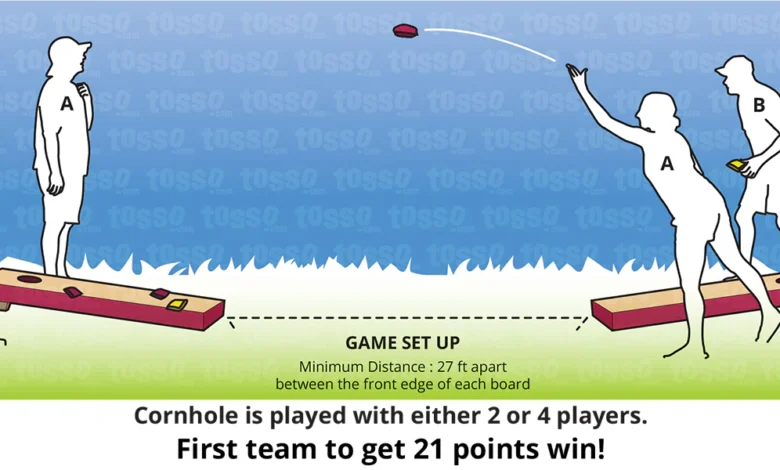The Perfect Cornhole Distance: A Guide to Mastering the Game

Introduction of Cornhole Distance
Picture this: It’s a sunny afternoon, the grill is fired up, friends and family are gathered in the backyard, and there’s a lively game of cornhole underway. The stakes are high, laughter fills the air, and everyone is vying for the title of cornhole champion. But what makes a cornhole game truly exciting and fair? The answer lies in one crucial detail: the cornhole distance. Have you ever wondered how far apart those boards should be for the best game experience? Let’s dive into the perfect cornhole distance and why it’s essential for your backyard fun.
Understanding the Cornhole Setup
Before we talk distances, let’s get familiar with the basic setup of a cornhole game. Cornhole is played with two boards, each featuring a hole near the top. Players take turns tossing bean bags from one board to the other, aiming to get them into the hole or as close as possible. Simple, right? But the placement of these boards is critical to ensuring a fair and enjoyable game.
Official Cornhole Distance
The official distance between the front edges of the two cornhole boards is 27 feet. This measurement is set by the American Cornhole League (ACL) and is the standard for competitive play. Why 27 feet, you ask? This distance strikes a balance between challenge and playability, making the game engaging for players of all skill levels. When boards are placed 27 feet apart, players have to use skill and strategy, rather than just power, to get their bags in the hole.
Setting Up for Casual Play
While the 27-foot distance is the gold standard for competitive play, you might want to adjust this for casual backyard games. If you’re playing with kids or beginners, setting the boards closer together, around 20 feet apart, can make the game more approachable and enjoyable. On the other hand, if you’re playing with seasoned cornhole enthusiasts, sticking to the official distance will keep the competition fierce and fair.
The Importance of Consistency
Consistency in the placement of your cornhole boards is crucial. Whether you’re playing a friendly match or a heated tournament, ensuring that the boards are consistently placed at the correct distance helps maintain the integrity of the game. Consistent distances mean that players cornhole distance can develop and refine their skills over time, leading to more competitive and exciting games.
Measuring the Distance
Measuring the correct distance for your cornhole boards doesn’t require any fancy tools. A standard tape measure will do the trick. Here’s a simple step-by-step guide to ensure your boards are perfectly placed:
- Place the Boards: Start by placing the boards roughly where you want them.
- Measure 27 Feet: Using the tape measure, measure 27 feet from the front edge of one board to the front edge of the other.
- Align the Boards: Make sure the boards are aligned straight. You can use a string or a straight edge to ensure they are perfectly in line.
- Check for Stability: Ensure the boards are on a flat surface and stable. Uneven or unstable boards can affect the gameplay.
Adjusting for Your Space
Not every backyard or playing area can accommodate the full 27-foot distance. If space is limited, don’t fret. Adjust the distance as needed to fit your area while keeping the game enjoyable. For smaller spaces, you might go as short as 15 feet, especially if you’re playing indoors or in a constrained environment. Just remember, the closer the boards, the easier the game becomes.
Practice Makes Perfect
Understanding and setting the correct distance is just the beginning. To become a true cornhole cornhole distance master, practice is key. Here are a few tips to improve your cornhole skills:
- Perfect Your Stance: Stand comfortably with your feet shoulder-width apart. Find a stance that feels balanced and allows for a smooth throw.
- Focus on Your Throw: Aim for a gentle arc in your throw. Too much power can cause the bag to bounce off the board.
- Learn to Adjust: Different environments can affect your throw. Practice in various cornhole distance settings to become adaptable.
- Watch the Pros: Observing skilled players can give you insights into techniques cornhole distance and strategies you might not have considered.
Playing in Teams
Cornhole is often played in teams, adding another layer of fun and strategy to the game. When playing in teams, partners stand on opposite sides and alternate turns. This setup means that communication and teamwork are essential. Encouraging your partner, strategizing cornhole distance about bag placement, and learning from each other’s throws can enhance the overall experience.
Cornhole Variations
While the traditional 27-foot distance is standard, cornhole can be adapted in many ways to keep things interesting. Here are a few variations you might try:
- Shorter Distance: Ideal for younger players or those new to the game.
- Longer Distance: A challenge for experienced players looking to up the difficulty.
- Obstacle Course: Add obstacles around the boards for a fun twist on the game.
- Timed Rounds: See who can score the most points in a set amount of time.
Conclusion: Finding Your Perfect Distance
Ultimately, the best cornhole distance is the one that brings the most joy to your game. Whether you stick to the official 27 feet or adjust based on your playing group and space, the key is to have fun and enjoy the game. Cornhole is a fantastic way to bring people together, spark friendly competition, and create lasting memories. So, grab your tape measure, set those boards up, and let the games begin!



